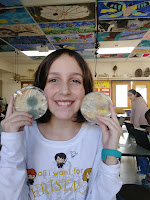Recently in math, the second graders have been exploring money. We began the process by taking a closer look at each of the different coins and challenging ourselves to see if we can correctly identify each coin. We have noticed that each coin gives us clues to help with this process.
We learned that the penny is worth one cent. We know that Abraham Lincoln is on the front of the penny and is facing right. The Lincoln Memorial is on the back and the penny is the only copper coin.
We know the nickel is worth five cents. We also know Thomas Jefferson is on the front of nickel and the White House is on the back. The nickel is silver.
We know that the dime is the smallest size coin, is silver and is worth ten cents. Franklin D. Roosevelt is on the front and a torch with an olive branch and oak tree branch is on the back.
We know that the quarter is the largest size coin out of the four that we are studying. It is worth 25 cents and is silver. The front of the quarter is always George Washington facing the left. There are also many different images on the back, one of which is the eagle.
One activity that second grade participated in was to see the different ways we could make 75 cents. The quickest combination was to use 3 quarters. This uses the fewest coins. We also discovered that using 75 pennies uses the most coins and would be the most "annoying, time consuming and overwhelming way to pay for one pretzel.
We also learned that if you are buying...
2 pretzels will cost $1.50
3 pretzels will cost $2.25
4 pretzels will cost $3.00
5 pretzels will cost $3.75
Some advice we have for the third graders when selling pretzels would be:
"Make sure you have a lot of pretzels to sell."
"If you have dimes remember to count by tens."
"Always start by counting the larger amount coins first."
"If you are unsure of the coin flip it over and see if you can identify it from the back."
" If you receive a dollar the person's change will always be 25 cents."
( This blog was written by the second graders who are excitedly awaiting pretzel day!)

















































